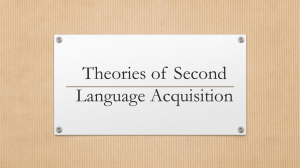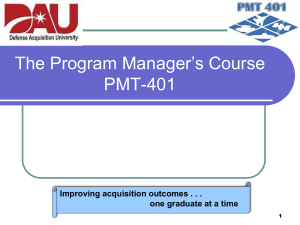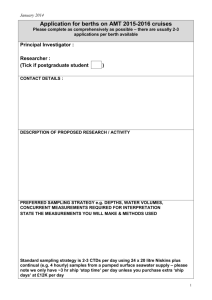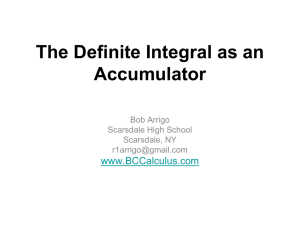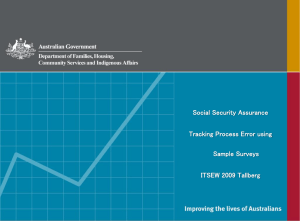Understanding by Design: Acquisition, Meaning, Transfer
advertisement
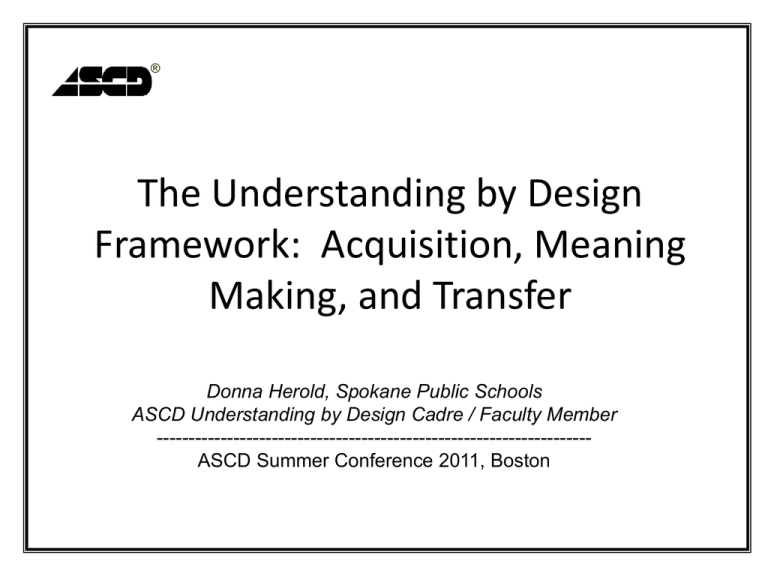
® The Understanding by Design Framework: Acquisition, Meaning Making, and Transfer Donna Herold, Spokane Public Schools ASCD Understanding by Design Cadre / Faculty Member -------------------------------------------------------------------ASCD Summer Conference 2011, Boston Describe an outstanding learning experience that you’ve had—as a student, teacher, in life. What made it effective or engaging for you? 2 3 Desired Understandings: • There are three distinct kinds of learning – acquisition (A), meaning making (M), and transfer (T)—and an Understanding by Design learning plan must address each • The roles of teachers and students vary according to the A-M-T goals • Acquisition of knowledge and skills is not the long-term learning goal but the means for students to illustrate understanding and transfer Learning to Transfer “The research is very clear on this point: students who really develop and ‘own’ an idea are more likely to successfully interpret new situations and tackle new problems than students who possess only drilled knowledge and skill.” — Wiggins and McTighe 4 Stages of lesson design: • Take a moment and think about a time when your students moved successfully through the stages of acquisition, meaning making, and arrived at transfer. • Consider the design characteristics of that lesson/unit. How did you plan for and create transfer? 8 Defining A M T – Acquire Information – Making Meaning – Transfer See page one of AMT Teaching Resources handouts 9 Acquisition A fact is a fact; a skill is a skill. We acquire each in turn. Acquisition does not yield understanding; it is necessary but not sufficient. If I have skills and facts, it does not mean that I understand. I cannot, however, understand without those skills and facts. Acquisition • Use a mnemonic system for remembering liquid/solid measurement equivalents. • Name the various sectors of the Hospitality industry. • Identify technology used in a business office. • List the 3 largest branches of the US Military. • Identify the job duties of a state legislator. • Identify and describe external variables. • Define various leadership styles. • Identify correct answer when prompted (fact recall, information retrieval) To access links not in PDF: http://livebinders.com/edit?id=128189 Acquisition Web Apps Flashcard Exchange Khan Academy Jeopardy Labs Visuwords More suggestions from the group: 13 Making Meaning What do these facts imply? When would I use this skill (or not)? What is their sense, import, value? Make Meaning Data Analysis: Students manipulate and interpret a data set using tables, graphs, charts, and other visual displays to draw conclusions, identify patterns, and make predictions Demonstration: Students teach a process, concept or problem through the use of models, explanations, illustrations, and/or inquiry so the audience understands it Concrete or Applied Response • Students provide a reasonable answer/explanation and evidence to support their thinking. Requires application of previous knowledge. Making Meaning Web Apps Gliffy Linoit Jing Livebinder More suggestions from the group: 16 Transfer How should I apply my prior facts, skills, and ideas effectively in this particular situation? The situation must be new and uncharted. The goal is independent transfer. Transfer Performance / Product: Generate a performance/product using visual, multimedia, Problem/Solution: Identify and define a sound, writing, and /or speech to demonstrate problem and generate a possible understanding and/or communicate creative solution(s) (or solution paths), evaluate intent. the viability of each solution, and offer a Modeling/Simulation: Given a model or set of recommendation. criteria/data/experiences, create Inquiry/Investigation: Develop questions and representations to illustrate/predict outcomes pursue an explanation/pattern based on, or to deepen understanding. but not limited to, known information. Correspondence/Interviews: Appropriately Source/Comparative Analysis: Analyze data, communicates to an audience and/or responds information, artifacts, and/or textual to an idea, point of view, concern, request or evidence to develop an explanation, proposal to achieve a desired result. interpretation, and/or determine impact. Persuasive statement: Develop an Critique/Self-Analysis: Evaluate a given text, argument/artifact using supporting information performance, or problem based on and persuasive techniques to promote a established criteria. particular point of view and/or to cause action. Debate, Panel, Role Play: Present and Portfolio/Reflection: Collect work over time to participate in a debate, panel, or role play demonstrate mastery in one or more modes of to provide information, gain insight and/or expression/College, Career & Citizen-Ready promote a particular point of view. Skills, reflect on growth, and/or set goals. Transfer Web Apps Prezi Weebly Animoto Teacher Challenge website More suggestions from the group: Some Examples of AMT A Students practice tying their shoes M Students draw/speak the steps of lace tying M T Students discuss the pros and cons of laces vs. Velcro, and different methods of tying Students teach others to tie rope or ribbons See page two of AMT Teaching Resources handouts Examples of AMT in Reading M Students read a story with new words important to the story A Students receive, learn, and memorize words from a vocabulary list M T Students group the words and consider: who needs to know this word? Students play Scrabble and do Crossword Puzzles See page two of AMT Teaching Resources handouts—page three for an additional exercise Acquisition Meaning Making Transfer Other AMT-like constructs: Gradual Release of Responsibility Rigor/Relevance Framework Acquisition, Meaning Making, Transfer Quad D Lessons & Assessments • • • • Math Social Studies Science English • From the 2010 NMSA Conference What instructional strategies do you frequently use in lesson design? List 10 instructional strategies you regularly use: 1. 2. 3. 4. 5. 6. 7. 8. 9. 10. Teacher Role and Instructional Strategies: Acquisition via Direct Instruction To inform the learners through explicit instruction in targeted knowledge and skills; differentiating as needed Lecture Graphic organizers Demonstration or modeling Process guides Guided practice Feedback, corrections 32 Teacher Role and Instructional Strategies: Make Meaning via Facilitative Teaching 33 To engage the learners in actively processing the information and guide their inquiry into problems, texts, or simulations, differentiating as needed Graphic organizers Concept attainment Problem based learning Formative assessments Rethinking and reflection prompts Using analogies Teacher Role and Instructional Strategies: Transfer via Coaching To coach the learners to independently perform in increasingly complex situations, provide models, and give ongoing feedback (as personalized as possible). Ongoing assessment, providing specific feedback in the context of authentic application Conferencing Provide just-in-time teaching (both individuals, small groups and whole class) when needed 34 35 Action Verbs for A-M-T GOAL TYPE ACTION VERBS apprehend • calculate • define • discern • identify • Acquisition memorize • notice • paraphrase • plug in • recall • select • state Making Meaning analyze • compare • contrast • critique • defend • evaluate • explain • generalize • interpret • justify/support •prove • summarize • synthesize • test • translate • verify Transfer adapt (based on feedback)• adjust (based on results) • apply • create • design • innovate • perform effectively • self-assess • solve • troubleshoot 10 Strategies Exercise: • Now go back to your list of the ten most commonly used strategies in your classroom. • Label each learning experience as A, M, or T. • Discuss: – Do your most commonly used strategies reflect a balance of A, M, and T? – If not, where do you tend to focus? – Where might you plan to adjust, if anywhere? 36 37 Designing and Teaching for Transfer Establish and keep highlighting clear transfer goals. Have learners practice judgment in using a few different skills, not just plugging in one skill on command. Provide students with feedback on their self-cueing, knowledge retrieval, self-assessment, and self-adjustment. Change the set-up so that students realize that use of prior learning comes in many guises. Have students regularly generalize from specific instances and cases. Require students to constantly reword, rephrase, and represent what they learn. 38 Task: Using the criteria on page four of the AMT teaching resources handouts: • Draft a learning plan for a unit of study. • Indicate lesson order, code with A-M-T See page four of AMT Teaching Resources handouts 39 Design Standards for Learning Plan • Are all three types of learning goals (A M T) addressed in my plan? • Have I sketched out learning events that are appropriate for each type of goal—rather than what is most familiar or comfortable? • Are there sufficient opportunities for students to draw inferences and make meaning on their own about the big ideas of the unit? • Have I sketched out a flow of the unit that gradually releases students to be more responsible for figuring out what to do and when to do it? See pages five and six of AMT Teaching Resources handouts For more information: • • • • • Donna Herold Donnaher@spokaneschools.org Ferris High School (509) 979-2521 http://www.21stcenturyschoolteacher.com 2011 ASCD Summer Pre-Conference/ Conference Evaluations http://www.ascd.org/evaluations Thank you for your comments!

